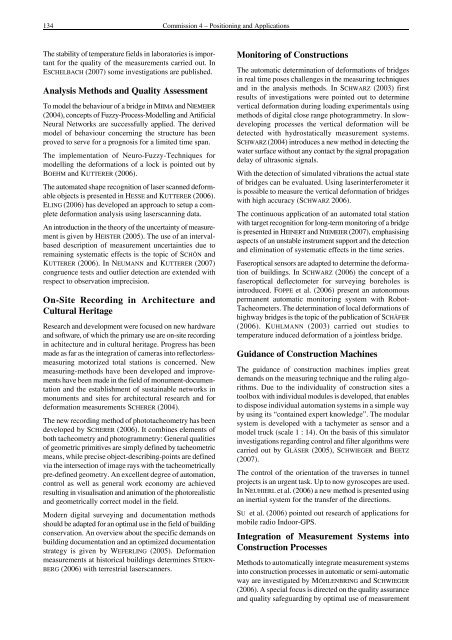NATIONAL REPORT OF THE FEDERAL REPUBLIC OF ... - IAG Office
NATIONAL REPORT OF THE FEDERAL REPUBLIC OF ... - IAG Office
NATIONAL REPORT OF THE FEDERAL REPUBLIC OF ... - IAG Office
Create successful ePaper yourself
Turn your PDF publications into a flip-book with our unique Google optimized e-Paper software.
134 Commission 4 – Positioning and Applications<br />
The stability of temperature fields in laboratories is important<br />
for the quality of the measurements carried out. In<br />
ESCHELBACH (2007) some investigations are published.<br />
Analysis Methods and Quality Assessment<br />
To model the behaviour of a bridge in MIIMA and NIEMEIER<br />
(2004), concepts of Fuzzy-Process-Modelling and Artificial<br />
Neural Networks are successfully applied. The derived<br />
model of behaviour concerning the structure has been<br />
proved to serve for a prognosis for a limited time span.<br />
The implementation of Neuro-Fuzzy-Techniques for<br />
modelling the deformations of a lock is pointed out by<br />
BOEHM and KUTTERER (2006).<br />
The automated shape recognition of laser scanned deformable<br />
objects is presented in HESSE and KUTTERER (2006).<br />
ELING (2006) has developed an approach to setup a complete<br />
deformation analysis using laserscanning data.<br />
An introduction in the theory of the uncertainty of measurement<br />
is given by HEISTER (2005). The use of an intervalbased<br />
description of measurement uncertainties due to<br />
remaining systematic effects is the topic of SCHÖN and<br />
KUTTERER (2006). In NEUMANN and KUTTERER (2007)<br />
congruence tests and outlier detection are extended with<br />
respect to observation imprecision.<br />
On-Site Recording in Architecture and<br />
Cultural Heritage<br />
Research and development were focused on new hardware<br />
and software, of which the primary use are on-site recording<br />
in achitecture and in cultural heritage. Progress has been<br />
made as far as the integration of cameras into reflectorlessmeasuring<br />
motorized total stations is concerned. New<br />
measuring-methods have been developed and improvements<br />
have been made in the field of monument-documentation<br />
and the establishment of sustainable networks in<br />
monuments and sites for architectural research and for<br />
deformation measurements SCHERER (2004).<br />
The new recording method of phototacheometry has been<br />
developed by SCHERER (2006). It combines elements of<br />
both tacheometry and photogrammetry: General qualities<br />
of geometric primitives are simply defined by tacheometric<br />
means, while precise object-describing-points are defined<br />
via the intersection of image rays with the tacheometrically<br />
pre-defined geometry. An excellent degree of automation,<br />
control as well as general work economy are achieved<br />
resulting in visualisation and animation of the photorealistic<br />
and geometrically correct model in the field.<br />
Modern digital surveying and documentation methods<br />
should be adapted for an optimal use in the field of building<br />
conservation. An overview about the specific demands on<br />
building documentation and an optimized documentation<br />
strategy is given by WEFERLING (2005). Deformation<br />
measurements at historical buildings determines STERN-<br />
BERG (2006) with terrestrial laserscanners.<br />
Monitoring of Constructions<br />
The automatic determination of deformations of bridges<br />
in real time poses challenges in the measuring techniques<br />
and in the analysis methods. In SCHWARZ (2003) first<br />
results of investigations were pointed out to determine<br />
vertical deformation during loading experimentals using<br />
methods of digital close range photogrammetry. In slowdeveloping<br />
processes the vertical deformation will be<br />
detected with hydrostatically measurement systems.<br />
SCHWARZ (2004) introduces a new method in detecting the<br />
water surface without any contact by the signal propagation<br />
delay of ultrasonic signals.<br />
With the detection of simulated vibrations the actual state<br />
of bridges can be evaluated. Using laserinterferometer it<br />
is possible to measure the vertical deformation of bridges<br />
with high accuracy (SCHWARZ 2006).<br />
The continuous application of an automated total station<br />
with target recognition for long-term monitoring of a bridge<br />
is presented in HEINERT and NIEMEIER (2007), emphasising<br />
aspects of an unstable instrument support and the detection<br />
and elimination of systematic effects in the time series.<br />
Faseroptical sensors are adapted to determine the deformation<br />
of buildings. In SCHWARZ (2006) the concept of a<br />
faseroptical deflectometer for surveying boreholes is<br />
introduced. FOPPE et al. (2006) present an autonomous<br />
permanent automatic monitoring system with Robot-<br />
Tacheometers. The determination of local deformations of<br />
highway bridges is the topic of the publication of SCHÄFER<br />
(2006). KUHLMANN (2003) carried out studies to<br />
temperature induced deformation of a jointless bridge.<br />
Guidance of Construction Machines<br />
The guidance of construction machines implies great<br />
demands on the measuring technique and the ruling algorithms.<br />
Due to the individuality of construction sites a<br />
toolbox with individual modules is developed, that enables<br />
to dispose individual automation systems in a simple way<br />
by using its “contained expert knowledge”. The modular<br />
system is developed with a tachymeter as sensor and a<br />
model truck (scale 1 : 14). On the basis of this simulator<br />
investigations regarding control and filter algorithms were<br />
carried out by GLÄSER (2005), SCHWIEGER and BEETZ<br />
(2007).<br />
The control of the orientation of the traverses in tunnel<br />
projects is an urgent task. Up to now gyroscopes are used.<br />
In NEUHIERL et al. (2006) a new method is presented using<br />
an inertial system for the transfer of the directions.<br />
SU et al. (2006) pointed out research of applications for<br />
mobile radio Indoor-GPS.<br />
Integration of Measurement Systems into<br />
Construction Processes<br />
Methods to automatically integrate measurement systems<br />
into construction processes in automatic or semi-automatic<br />
way are investigated by MÖHLENBRING and SCHWIEGER<br />
(2006). A special focus is directed on the quality assurance<br />
and quality safeguarding by optimal use of measurement











